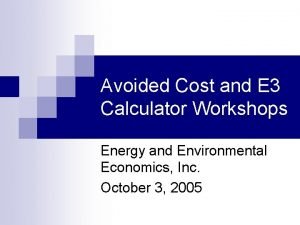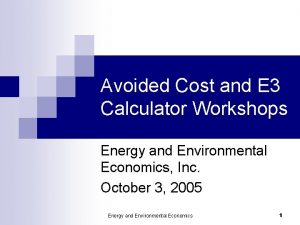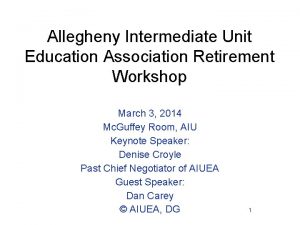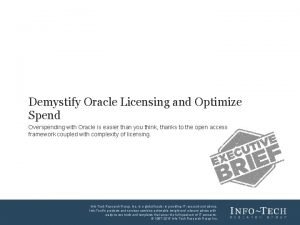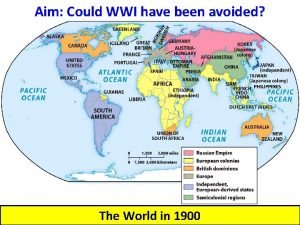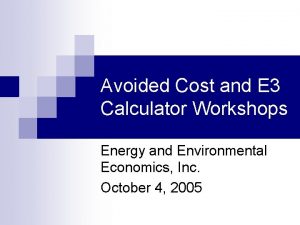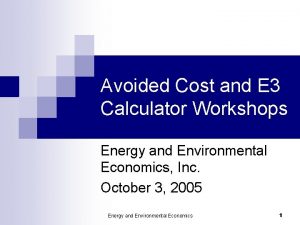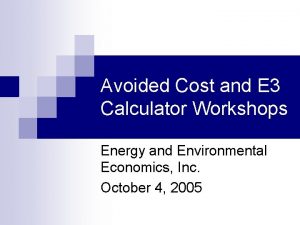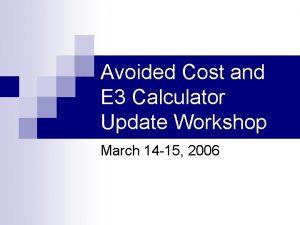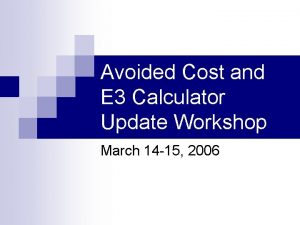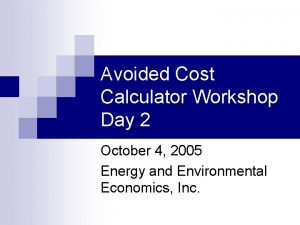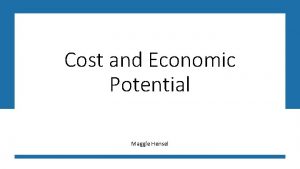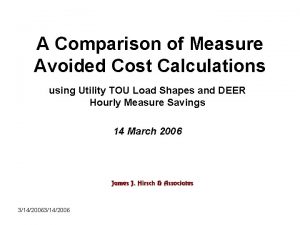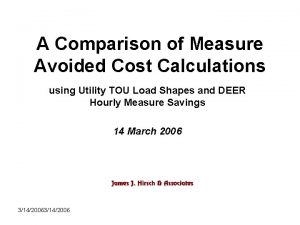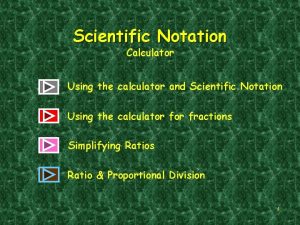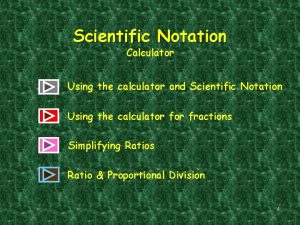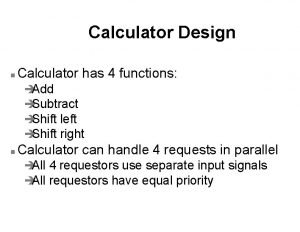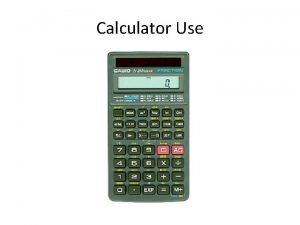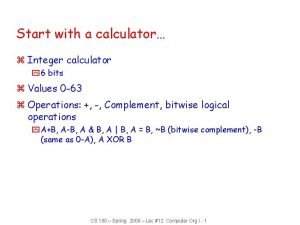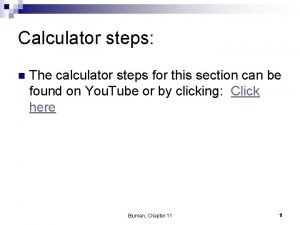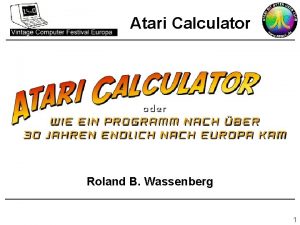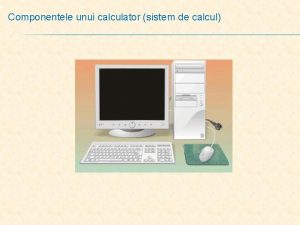Avoided Cost and E 3 Calculator Workshops Energy





























- Slides: 29

Avoided Cost and E 3 Calculator Workshops Energy and Environmental Economics, Inc. October 3, 2005 Energy and Environmental Economics 1

Existing Summer Peak TOU Period Definitions n Summer Season n Summer Peak Period Hours Energy and Environmental Economics 2

Costs by TOU Period (NP-15, 2008) n Average Gen + Emission cost for NP-15 ($/MWh) n Avg Gen + Emission using SCE TOU Periods Energy and Environmental Economics A June through September program would be valued higher under SCE’s definition 3

Variation of Avoided Gen + Env Costs within PG&E’s Summer Peak Period Energy and Environmental Economics 4

Costs by TOU Period (SP-15) n SCE ($/MWh 2008) n SDG&E ($/MWh 2008) Energy and Environmental Economics 5

Review of Available End Use Information Energy and Environmental Economics 6

PG&E Hourly Shapes Energy and Environmental Economics 7

Shape Cautions PG&E’s hourly shapes reflect the average usage of an end use, not necessarily the savings profile for a measure. n TOU shapes are generally old and difficult to reproduce. n Energy and Environmental Economics 8

Deer Shapes Energy and Environmental Economics 9

Review of E 3 calculator’s use of avoided costs and end use information Pre-processing Energy and Environmental Economics 10

Calculators Make use of Pre. Processed End Use Shapes n n Pre-processing allows for the detail from the hourly avoided costs and the hourly end use shapes to be captured, while streamlining program design and evaluation. Pre-processing basically takes a normalized end use load shape and multiples it against the hourly avoided costs. The resulting hourly benefits are then summed into four quarters for each year of the 20 year forecast period. For each year, 8760 hourly values are condensed to four values. Because the load shape information and the cost information are multiplied at the hourly level BEFORE summation into quarters, there is NO loss of precision. The quarterly benefits by end use (and by climate zone) are the building blocks for the cost effectiveness evaluation in the Calculators. For those cases where hourly load shapes do not exist, TOU values were used. TOU will be less precise. Energy and Environmental Economics 11

Pre-processing – Hourly Loads n Hourly Shapes (by sector, measure, CZ) ¨ Multiply against 8760 hr x 30 yr x 10 Climate zones (if shapes applies to all CZs) ¨ Calculate avoided costs by quarter for each shape Generation (energy and capacity combined) and emissions n T&D capacity allocated to hours n Energy and Environmental Economics 12

Pre-processing example Hourly Avoided Costs ($/k. Wh) X Hourly Shape (k. Wh/hr) = Hourly Benefits ($/hr) Qtr 1 Qtr 2 Qtr 3 Energy and Environmental Economics Qtr 4 13

Pre-processing – Hourly Loads n Hourly Shapes (by sector, measure, CZ) n Average Monthly Peak and Non-coincident peaks for 12 months ¨ ¨ n Annual values ¨ ¨ ¨ n Average monthly peak is the average demand reduction during the five highest system hours for each month. Non-coincident[month] peak is the highest demand reduction during the month. Avg July-Sept Peak: Average monthly peak reduction for the three months. Avg Dec-Feb Peak: Average monthly peak reduction for the three months Non-coincident[year] peak is the highest Non-Coincident[month] value. Note that DEER k. W numbers are NOT used Energy and Environmental Economics 14

Pre-processing: TOU Factors n TOU Costing Period Factors ¨ Average hourly avoided energy costs across TOU periods ¨ Sum hourly capacity costs (T&D) across TOU periods. ¨ Calculate avoided costs by quarter for each shape n n Generation energy and emission costs * TOU k. Wh shape T&D Capacity by TOU * TOU k. W shape ¨ Calculate n n Monthly Average and Non-coincident Peaks Concident = Summer on-peak TOU factor Non-coincident: Use highest of seasonal TOU factors Energy and Environmental Economics 15

TOU k. W and DEER k. W Calculated k. W and DEER k. W will not match for these shapes. 16 Energy and Environmental Economics SDG&E has a workaround that uses the DEER values for reporting

TOU example TOU Avoided Costs ($/k. Wh) Summer On Ptl Off Winter On Ptl Off X TOU Shape (k. Wh/hr) = TOU Benefits ($/hr) Qtr 1 Qtr 2 Qtr and 3 Environmental Qtr 4 Energy Economics 17

The E 3 Calculator Energy and Environmental Economics 18

Purpose of the Calculators n Provide a tool that allows users to input program information and select from pre-determined enduse shapes to calculate program cost effectiveness. ¨ Preprocess n hourly data to a more manageable form Allow easy calculation of measure benefits by climate zone ¨ Recognizes both the shape and cost differences by climate zone. Energy and Environmental Economics 19

Calculator Tabs Users will only interact with these three tabs n Input: All user inputs describing program and measures n Output: Program overall impacts, and by sector and quarter Output-Measure: Impacts for each measure n The remaining tabs are used for the calculations, and may be locked or hidden in the final version Calculations: The calculations n Cost. G: Avoided costs for Gas n Cost. E: Pre-processed data for electric n Policy. Manual: Inputs for NTG Ratio and measure life. n Energy and Environmental Economics 20

Review of the Calculator Operations How pre-processed shapes are used in the Calculator n Use of annual k. Wh to scale impacts n Secondary role of k. W for n ¨ k. W-factor TOU shapes ¨ T&D capacity costs n Use of whole year End Use Life Energy and Environmental Economics 21

Review of Issues – Types of k. W ¨ Coincident ¨ Avg July-Sept ¨ Monthly ¨ Avg Dec-Feb ¨ Noncoincident (annual and monthly) ¨ “CEC k. W” 0. 217 Factor ¨ Average daily peak Energy and Environmental Economics 22

Review of Issues – Counting Period n Annual k. W achievements ¨ Achievements based on incremental installations n Peak based on when unit is committed n Peak based on year unit is installed (e. g. , Annual Net k. Wh) n Peak based on whether unit is in place prior to the summer period n Achievements based on units in place at a snapshot in time ¨ Peak based on units installed by the snapshot time based on units installed AND still working at the time of the snapshot n Include installations past 2008? Energy and Environmental Economics 23

Utility Differences Energy and Environmental Economics 24

Standard Practice Manual n Tech. Market asserts that PAC (BC Ratio? ) should always be > TRC since TRC includes “all costs” ¨ n It is E 3’s understanding that TRC excludes transfer payments (incentives). So large incentives could increase PAC costs above TRC levels. There is an issue with load building programs. The calculator treats load increases as a negative benefit, rather than reclassifying it as a positive cost. This is inconsistent with the SPM, and would affect the BC ratios (but not the net benefits). ¨ However, whether it is a negative benefit or positive cost will never change the B/C ratio being greater than or less than 1. 0 ¨ Energy and Environmental Economics 25

The B/C unity relationship does not change n n Assume b is the negative benefit (cost increase) of a load increase. The total benefit is (a-b) and the cost is c. If the program is cost effective, the B/C ratio is: (a-b)/c > 1 This can be re-expressed as follows: (a-b) > c ¨ a > c+b ¨ a/(c+b) > 1 ¨ n The last equation is the case where b is reclassified as a cost and included in the denominator. The algebra shows that the “>1” relationship remains the same, regardless of the classification of b. Energy and Environmental Economics 26

Identification of Issues around Peak Demand Definition n Overall Commission direction n Parameters by which utilities’ portfolio performance in terms of peak load reductions will be evaluated. Adequate capture of the value of critical peak reduction Update our peak savings for 2009 based on studies of peak savings potential, rather than historical program performance Energy and Environmental Economics 27

Existing Demand Definitions and Requirements n Coincident demand ¨ n TOU already exists, and hourly could conform. Avg daily demand ¨ n Hourly data needed. TOU data must be assigned an assumed relationship to peak. Hourly data is best. TOU data would need to be apportioned to new period. DEER demand ¨ Relationship to a “peak” period is unclear (timing of load reductions at that level) Energy and Environmental Economics 28

Issues Related to Demand Definition n Uniform definition needed across proceedings? Energy and Environmental Economics 29
 Avoided cost calculator
Avoided cost calculator Avoided cost example
Avoided cost example Read 180 overview
Read 180 overview Psea retirement workshops
Psea retirement workshops Mbti activities for small groups
Mbti activities for small groups Cramped workshops set up in shabby tenement buildings
Cramped workshops set up in shabby tenement buildings Danio kwark gezond
Danio kwark gezond Can665.com
Can665.com Oracle licensing workshops
Oracle licensing workshops Social thinking model
Social thinking model Nature explore workshops
Nature explore workshops Icef toronto
Icef toronto Canadian bioinformatics workshops
Canadian bioinformatics workshops Canadian bioinformatics workshops
Canadian bioinformatics workshops Canadian bioinformatics workshops
Canadian bioinformatics workshops Canadian bioinformatics workshops
Canadian bioinformatics workshops This can be avoided by giving credit where credit is due.
This can be avoided by giving credit where credit is due. How could the french revolution been avoided
How could the french revolution been avoided Could ww1 have been avoided
Could ww1 have been avoided How could the french revolution have been avoided
How could the french revolution have been avoided Incomplete casting
Incomplete casting Which egyptian ruler avoided military conquests
Which egyptian ruler avoided military conquests Energy energy transfer and general energy analysis
Energy energy transfer and general energy analysis Energy energy transfer and general energy analysis
Energy energy transfer and general energy analysis Cost accumulation and cost assignment
Cost accumulation and cost assignment Cost accumulation and cost assignment
Cost accumulation and cost assignment Cost pools
Cost pools Cost accumulation and cost assignment
Cost accumulation and cost assignment Dennis geyer
Dennis geyer Characteristics of standard costing
Characteristics of standard costing
